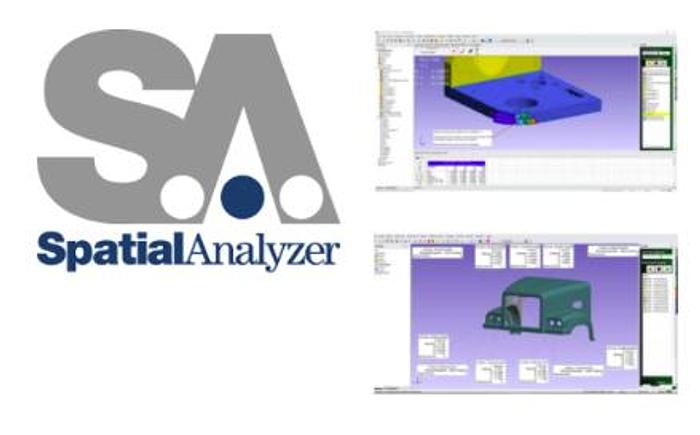SPATIAL ANALYZER
SPATIAL ANALYZER
Description
SpatialAnalyzer is the premier portable metrology software solution for large-scale applications. SA is an instrument-independent, traceable 3D graphical software platform that makes it easy for users to integrate data from multiple instruments and perform complex tasks simply, ultimately improving productivity. Click below for watch a video that will introduce you to the power of SA.
Manchester Metrology has seats available for hire and purchase, they also offer 3-day training courses for groups up to 6 people. Spatial Analyzer is for use with most CMM, Portable CMM, Faro Gage and Laser trackers.
OVERVIEW
Spatial Analyzer Professional – Spatial Analyzer Professional with Native CAD is the professional measurement, alignment, inspection, analysis, and reporting software for all portable metrology instruments. In addition to all essential measurement needs, it includes several key inspection features, geometry inspection, and measurement automation.
Spatial Analyzer Ultimate – Spatial Analyzer Ultimate plus Native CAD is the premier measurement, optimization, analysis, reporting, and automation software suite for all portable instruments. Spatial Analyzer Ultimate is inclusive of everything contained in Spatial Analyzer Professional, plus some additional features.
FEATURES
Spatial Analyzer Professional
Full Support for Multiple Portable Metrology Instruments – Spatial Analyzer can simultaneously communicate with virtually any number and type of portable metrology instruments. This includes laser trackers, arms, laser radars, scanners, projectors, theodolites, total stations, and photogrammetric devices–all featuring a common interface for each instrument class.
Measurement – 100% traceability from measurement to reporting.
Alignment – A variety of alignment methods ranging from traditional 3-2-1 alignments to more advanced surface fits.
Build – Relationships are dynamic in nature and update automatically if part alignment or data changes.
Evaluation & Analysis – Permits both graphical and numerical depiction of measurement uncertainty.
Reporting – Quick, user-friendly reporting functionalities.
GD&T Inspection – Import CAD with GD&T annotations, create annotations manually, and inspect to GD&T standards with real-time reporting.
Geometry Inspection – Define design-based inspection routines from a CAD model or primitive geometry.
Native CAD – Import support for such major applications as CATIA V4, V5, Pro/Engineer, SolidWorks, Unigraphics, and other CAD formats.
Spatial Analyzer Ultimate
All the features of Spatial Analyzer Professional with these additional features.
Real-Time Alignment – Track moving parts in real-time so that you can monitor a part’s position as it is guided into place.
Advanced Fit Optimization – Provides the power necessary for advanced alignments and can help bring an out-of-tolerance part back within tolerance. You can also define fit envelopes to satisfy multiple constraints/ requirements.
Complex Instrument Networks (USMN) – A powerful feature that leverages the uncertainty characteristics of different instruments to provide a much more accurate instrument network than that of traditional alignment methods.
Automation – Generate simple to complex scripts that will greatly improve workflow and productivity, eliminate errors and save significant resources.
Pipe Fitting – Used in large piping applications when precision measurements and optimization are required.
Database Output – An additional reporting feature that allows you to transfer SA data to databases and track projects/data long-term.
SYTEM REQUIREMENTS
Minimum Requirements
– Microsoft Windows 7 or later
– 4 GB ram
– 500 MB of free disk space
– 1024 x 768 screen resolution
Recommendations for Optimal Performance:
The system outlined will provide a good base platform for using the most advanced features of SA. With this equipment measurement data may be gathered with high data rates (1 kHz sampling rates) into complex models containing numerous CAD surfaces.
– 3 Ghz Dual Core Processor
– Windows 7™ (64-bit)
– 8 GB of RAM (64 bit operating system)
– 1280×1024 or higher screen resolution
– Hardware-accelerated graphics card supporting OpenGL®
– 1 GB of free disk space
Specifications
| Condition | New |








